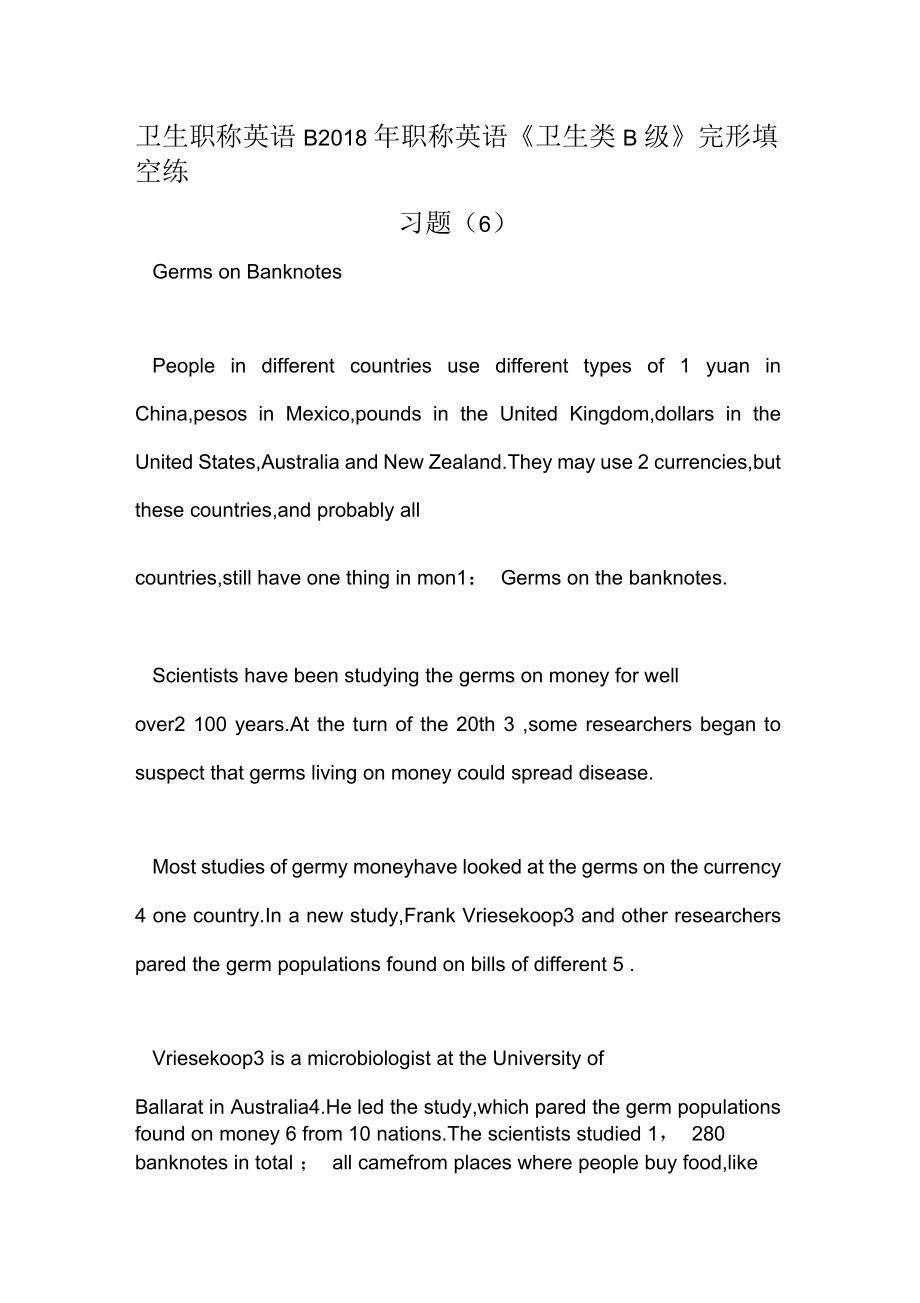《衛(wèi)生職稱英語(yǔ)B2018年職稱英語(yǔ)《衛(wèi)生類B級(jí)》完形填空練習(xí)題(六)》由會(huì)員分享�,可在線閱讀�,更多相關(guān)《衛(wèi)生職稱英語(yǔ)B2018年職稱英語(yǔ)《衛(wèi)生類B級(jí)》完形填空練習(xí)題(六)(7頁(yè)珍藏版)》請(qǐng)?jiān)谘b配圖網(wǎng)上搜索。
1��、衛(wèi)生職稱英語(yǔ)B2018 年職稱英語(yǔ)衛(wèi)生類B 級(jí)完形填空練習(xí)題(6)Germs on BanknotesPeople in different countries use different types of 1 yuan in China,pesos in Mexico,pounds in the United Kingdom,dollars in the United States,Australia and New Zealand.They may use 2 currencies,but these countries,and probably allcountries,still ha
2���、ve one thing in mon1: Germs on the banknotes.Scientists have been studying the germs on money for wellover2 100 years.At the turn of the 20th 3 ,some researchers began to suspect that germs living on money could spread disease.Most studies of germy moneyhave looked at the germs on the currency 4 one
3���、 country.In a new study,Frank Vriesekoop3 and other researchers pared the germ populations found on bills of different 5 .Vriesekoop3 is a microbiologist at the University ofBallarat in Australia4.He led the study,which pared the germ populations found on money 6 from 10 nations.The scientists studi
4�、ed 1��, 280 banknotes in total ��; all camefrom places where people buy food,like supermarkets street vendors and cafes,7 those businesses often rely on cash.Overall,the Australian dollars hosted the fewest livebacteria no more than 10 per square centimeter.Chineseyuan had the most about 100 per square
5���、centimeter.Most of the germs on money probably would not cause harm.What we call paper moneyusually isnt madefrom paper.The U.S.dollar,for example,is printed on fabric that is mostly8 .Different countries may use different 9 to print their money.Some of the currencies studied by Vriesekoop and his 1
6��、0 such as the American dollar were made from cotton.Others were made from polymers.The three 11 with the lowest numbers of bacteria were all printed on polymers.They included the Australian dollar,theNew Zealand dollar and some Mexican pesos.The other currencies were printed on fabric made 12 of cot
7�、ton.Fewer germs lived on the polymer notes.This connection suggests that 13 have a harder time staying alive on polymer surfaces.Scientists need to do more studies to understand how germs live on money and whether or not we need to be concerned.Vnesekoop is now starting a study that will 14 the amou
8���、nts of time bacteria can stay alive on different types of bills.Whatever Vriesekoop finds,the fact remains : Paper money harbors germs We should wash our 15 after touching it ���; after all5,you never know where your money s been.Or whats living on it練習(xí):1 .A coins B money C cheques D loans2 .A differen
9、t B clean C hard D foreign3 .A anniversary B year C decade D century4 .A along B with C within D outside5 .A countries B areas C regions D provinces6 .A delivered B borrowed C gathered D designed7 .A because B though C when D where8 .A plastic B rubber C cotton D paper9 .A languages B colors C subst
10�、ances D materials10 .A family B team C advisor D boss11 .A expenses B banks C statements D currencies12 .A nearly B mostly C likely D merely13 .A dirt B water C germs D oil14 .A pare B connect C conduct D mand15 .A arms B hands C face D clothes答案與題解:1.B 冒號(hào)后面說(shuō)的是各國(guó)使用錢(qián)幣的名稱:yuan in China ,pesos in Mexic
11��、o�, pounds in the United Kingdom , dollars in the United States , Aus往alia and New Zealand ,所以填人的詞必 定與這些錢(qián)幣有關(guān),而且應(yīng)該是錢(qián)幣的總括詞��。因此選money 最為恰當(dāng)��。 coins 是 硬幣 ��, cheques 是 支票 ���, loans 是 貸款 �,它們都不會(huì)是答案�。2 .A 本題的句子說(shuō)的是:雖然各國(guó)使用的紙幣各不相同,它們有一個(gè)共同點(diǎn)��,那就是紙幣上有病菌���。 四個(gè)選項(xiàng)中different 是答案�。3 .D 選 century 最合理��。 選 anniversary (周年) ��, year (年)
12�、或decade都不合邏輯���。4 .C 本段第二句提供了解答本題的線索��。Frank Vriesekoop 的研究與以前的科學(xué)家的研究不同��,他比較了各國(guó)錢(qián)幣上的病菌數(shù)量, 在他之前的科學(xué)家的研究范圍局限于一個(gè)國(guó)家的紙幣�。四個(gè)選項(xiàng)中只有within 表達(dá) 在(一個(gè)國(guó)家)里的意思。5 .A 經(jīng)過(guò)第四題選詞的思索過(guò)程�,本題的形容詞很自然會(huì)在different之后用 countries ,指不同的國(guó)家��。6 .C 上一句說(shuō)Vriesekoop 比較不同國(guó)家紙幣攜帶病菌的數(shù)量���。本題的句子明確指出他對(duì)比的紙幣涉及十個(gè)國(guó)家���。四個(gè)選項(xiàng)中只有g(shù)athered (收集)與上下文的意思相匹配。7 .A 填詞所在的句子與前面
13���、的主句存在因果關(guān)系��。為什么要從食品店和食品攤收集紙幣呢���?因?yàn)檫@些地方常要用現(xiàn)金支付。本題答案是 because.8 .C fabric 是 織物 ��,其制作原料不會(huì)是plastic (塑料)或rubber ( 橡膠)。選paper 也不對(duì) , 因?yàn)楸揪涫钦f(shuō)明紙幣的制作原料通常不是紙�。制作fabric 的原料是cotton ( 棉花),這是合乎常理的��。而且該段倒數(shù)第二句也提供了答案�。所以答案是cotton.9 .D 本段說(shuō)紙幣的材料一般不是紙,通常是用棉花織物或高分子聚合物制作的��。所以選擇materials ( 材料��、原料)是正確的���。10 .B 本題應(yīng)當(dāng)選team. 與 family (家庭成員)
14��、���,advisor (顧問(wèn))或 boss (老板)合作研究不是沒(méi)有可能,但總有些離譜��。與團(tuán)隊(duì)合作研究比較合理�。11 .D 本段第二句提供了線索,它列出三種紙幣���,即theAustralian dollar �, the New Zealand dollar 和 some Mexican pesos. 選 currencies 是最合理的。另外三個(gè)選項(xiàng)都不合適�; expenses 是 支出 ��, banks 是 銀行 ���, statements 是 賬單 ���。12 .B 本題只有選mostly ,上下文意思才連貫�。13.C 前一句說(shuō)用高分子聚合物制作的錢(qián)幣含菌數(shù)量較少。本題的句子接著分析說(shuō)�,在高分子聚合物上
15、存活較難�。誰(shuí)存活較難?當(dāng)然是病菌���。本題答案是germs0 dirt,water 和 oil 是非生物���,不存在生存的問(wèn)題。14.A四個(gè)選項(xiàng)填入句子后�,句子成了:”pare/connect/conduct/mand the amounts of time bacteria can stay alive on different types of bills,很明顯;connect (連接)/conduct (實(shí)施)/mand (控制)amounts of time 是無(wú)法成立 的�。 只有pare( 比較) 不同紙幣上病菌存活的時(shí)間才是Vriesekoop 要研究的新課題���。15.B 人們通常是用手接觸紙幣的。所以接觸紙幣后要洗手��。答案 是 hands.內(nèi)容僅供參考
 衛(wèi)生職稱英語(yǔ)B2018年職稱英語(yǔ)《衛(wèi)生類B級(jí)》完形填空練習(xí)題(六)
衛(wèi)生職稱英語(yǔ)B2018年職稱英語(yǔ)《衛(wèi)生類B級(jí)》完形填空練習(xí)題(六)

